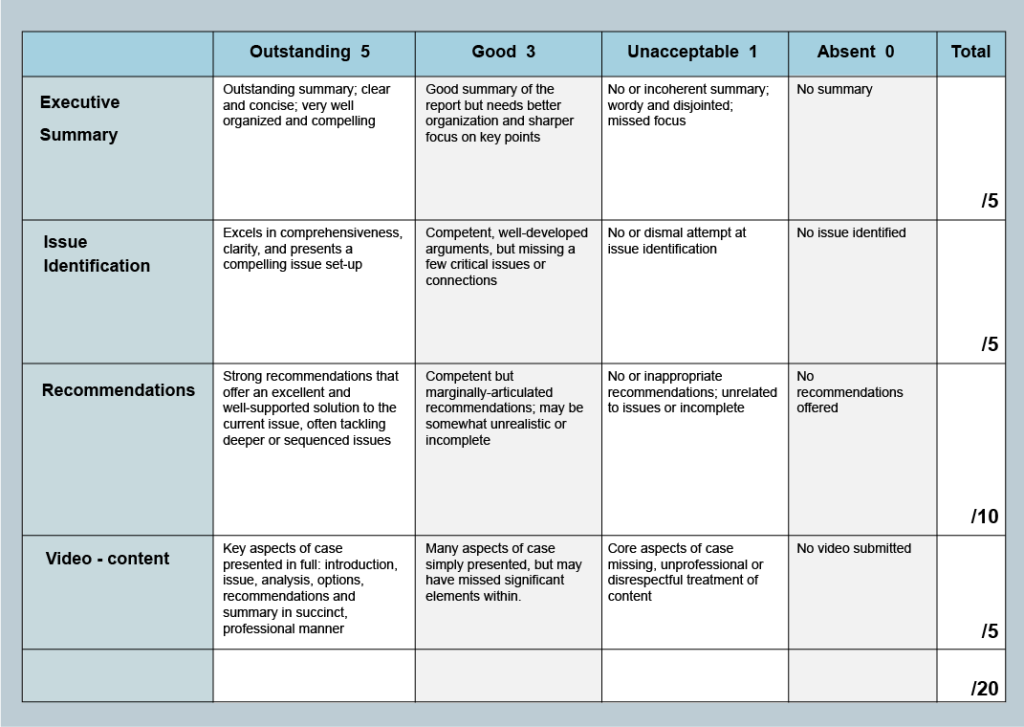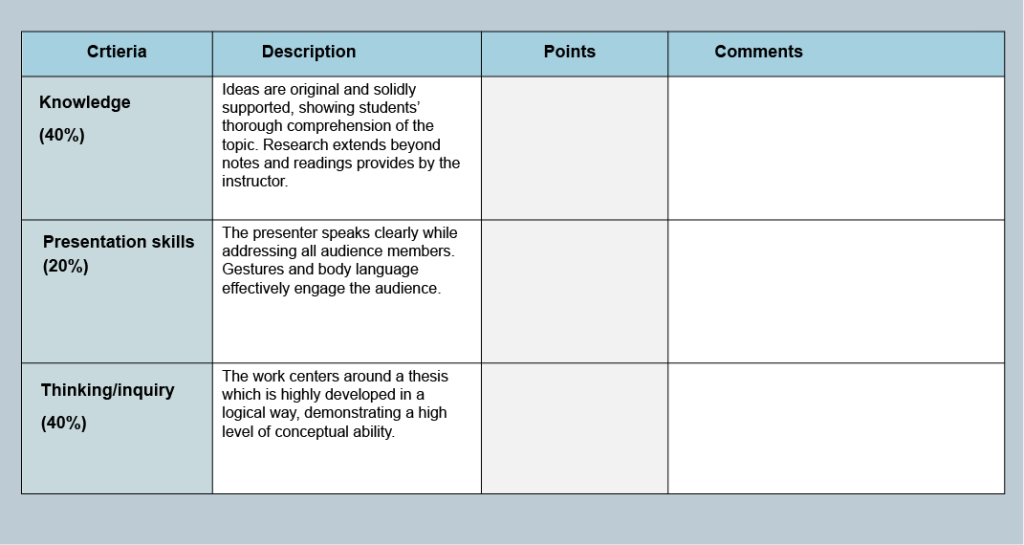What type of rubric should I use?
There are two well-known and commonly used types of rubrics, Analytic and Holistic, and two lesser-known types of rubrics, Scoring Guide and Single-Point.
Analytic Rubric
multiple levels of performance scales used that focus on one criterion at a time

Adapted from BUSINESS 6055 Group Case Project: Report and Video Presentation Rubric
with permission from Marc Kielly
[Download Full Rubric Example]
Analytic rubrics (also known as developmental rubrics) provide a list of all assignment criteria with detailed descriptions based on performance level of the criteria. The grader evaluates each criteria and sums up the points for all criteria when assigning an overall grade.
Analytic Rubrics are useful for formative assessment as they provide detailed feedback to students, one criteria at a time, allowing students to see how well they performed on specific aspects of the assignment. This will help students improve their work. They may also be used for summative feedback on students’ progress through a course or program. Analytic rubrics are often used when content or assignments are scaffolded, to give students some feedback on their learning progress before their final assignment.
Note
See below for a list of words to use as a performance level descriptors.
Holistic Rubric
one performance scale used that applies all criteria at the same time thereby focusing on the level of quality; typically includes detailed comments
Holistic Rubrics provide detailed performance level descriptions for all criteria, simultaneously. They give an overall big picture of the student’s work, with a focus on that they can do. There are typically 4 levels in a scale. The grader uses the description in whole when assessing the degree to which a student’s submitted work meets the criteria, and a single score is assigned. Some rubrics include a space for a general statement on the work as a whole. Specific feedback on elements is not provided. Holistic rubrics sometimes follow upon previous feedback given on one aspect of a student’s work. Weighting of criteria is not typically employed.
They are more useful than analytic rubrics for summative assessments where only the grade is pertinent. Choosing one score can be challenging when you are considering multiple criteria at one time.
Holistic rubrics “describe the work by applying all the criteria at the same time and enabling an overall judgment about the quality of the work.”
(Brookhart, S. M., 2013, p. 6).
Scoring Guide Rubric
one level describing the highest level of performance to which students should strive; include criteria, points and comments
Scoring Guide rubric’s criteria have one level each. The criterion can be weighted by including a percentage denoting its value towards the overall grade of the work being assessed. They also have columns for comments and points. The points indicate the degree to which a criterion is met (equivalent to how much credit the earn); for example, if a student, in answering an essay question, addresses all aspects of the question fully they would get full credit, partial credit for providing some or most parts, and zero for answering all parts incorrectly or not at all. So, if a student addressed most aspects of a question they would get 2/3 or 4/5 of the value of each criterion towards their grade on that question.
They are more expedient than free style assessment as the criteria and description of exemplary work is pre-identified. Grading strong work takes little time as fewer comments are needed. While grading weaker work may take longer as more details about how the work missed the mark or could be improved would need to be provided.
Some uses include low-stakes, formative assessments (not always entered in gradebook) like assessing participation in discussions. Other uses include assessments that have a single response, contract grading or situations where a PASS/FAIL is all that’s needed. A challenge with scoring guides is that their focus tends to be on how much of a submission met the mark (quantity) rather than how well it was done. This may very well be appropriate in some situations. Detailed feedback is not typically provided. When it is, a comments field is included to explain to students how they did or did not meet the criterion.
Single-Point Rubrics
a list of criteria with two levels to indicate its presence or absence; space to note strengths and concerns; one grade may be provided for the work as a whole
Single-point rubrics, also known as checklists, identify the success criteria for grading an assessment. Each criteria is presented in its own row. The criteria column is flanked on either side with space to provide specific feedback relating to any concerns (notes for what needs improvement) or strengths (notes on how the work exceeded expectations) observed in the work while grading. These two levels denote evidence of the criteria as present or not. They often use a concerns/strengths, Yes/No, Present/Not Present or Achieved/Not Achieved model for their two levels. Points (grades) are determined by tallying all the criteria that were denoted as present. Weighting of criteria is uncommon.
These rubrics are easy and quick to analyze. They are often used in performance evaluations (processes) and in peer evaluations. The grading tends to be fairly consistent over multiple uses. However, depending on how they are designed, single-point rubrics may require more detailed feedback from the instructor to indicate any concerns or strengths noted in observing the assessment item.
Originally Published: August 4, 2023






